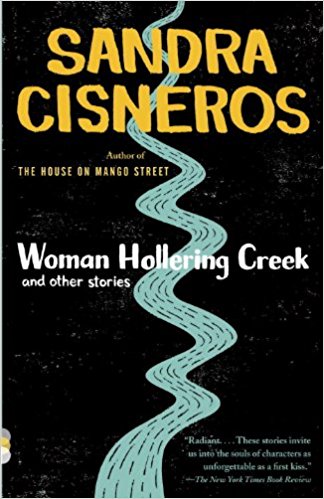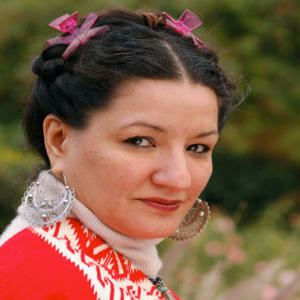Woman Hollering Creek Summary
6 min read ⌚
 Women of the world, unite! You’ve suffered way too long!
Women of the world, unite! You’ve suffered way too long!
And if you need some hope, some beacon of light in the dark, read Sandra Cisneros’ “Woman Hollering Creek.”
But be sure to prepare some tissues and, more importantly, arrange a ride.
Who Should Read “Woman Hollering Creek”? And Why?
“Woman Hollering Creek” is the title story of “Woman Hollering Creek and Other Stories.” Which, almost by definition, makes it the one Sandra Cisneros herself thinks you’re most obliged to read.
And if Cisneros thinks that, you don’t need a second invitation. Whether you’re a woman – in which case this story will touch you to your core – or a man – in which case, you are bound to be ashamed of your sex! – “Woman Hollering Creek” is a must-read.
And, you know what, you can read it right away here.
Sandra Cisneros Biography
Sandra Cisneros is a Mexican-American writer.
is a Mexican-American writer.
Born in 1954, she debuted at the age of 30 with The House on Mango Street, a critically acclaimed semi-autobiographical bildungsroman which “conveyed the Southwestern Latino experience with verve, charm, and passion.” (Oscar Hijuelos).
She followed the success with a collection of poems, “My Wicked, Wicked Ways,” and a collection of short stories, “Woman Hollering Creek and Other Stories.” Published in 1991, the latter was honored with numerous awards and secured her status as the leading Chicano writer.
Since then, she has published seven more books, among them “Caramelo” (2002) and, most recently, “House of My Own” (2015).
Plot
Please, step with us into the shoes of Cleófilas Enriqueta DeLeón Hernández, wife of Juan Pedro Martinez Sanchez, a mother of one, and, unfortunately, even today, a synecdoche for millions of women worldwide.
A few years ago, her father, Don Serafin, had given her into marriage to Juan Pedro who took her across the border to Seguin, Texas, United States of America.
“I am your father,” Don Serafin had said to her that day, “I will never abandon you.”
Poor Cleófilas!
She was too busy looking for Chela, her maid of honor, to be attentive to her father’s words. But now, a few years later, they ring with the echo of repentance and the power of hope.
Mainly because her husband Juan Pedro didn’t exactly turn out to be what she expected him to.
Though, to be fair, her expectations were based on a flawed premise in the first place.
Because, you see, back in her humble hometown of Monclova, Coahuila, Cleófilas didn’t have many things to do but watch her aunts play cards or scrutinize the same films in the cinema again and again.
Or visit her girlfriend’s house to watch the latest episode of her favorite telenovela, “Tu o Nadie.”
Which is Spanish for “You or No One.”
Which, in turn, is English for “It Doesn’t Work That Way in Real Life”!
Though, it seems it would – at the beginning.
The newlyweds Juan Pedro and Cleófilas are laughing as they drive over a creek, an arroyo, located just behind their about-to-become new home.
And the thing which makes them laugh?
“La Gritona,” the name of the creek.
Which is Spanish for “Woman Hollering.”
Which is English for “Bad Omen”:
The first time, she had been so surprised she didn’t cry out or try to defend herself. She had always said she would fight back if a man, any man, were to strike her.
But when the moment came, and he slapped her once, and then again, and again, until the lip split and bled an orchid of blood, she didn’t fight back, she didn’t break into tears, she didn’t run away as she imagined she might when she saw such things in the telenovelas.
You see, there’s a lot of passion in the telenovelas. And sometimes, this passion amounts to fight and a blow or two; but – if you’ve ever watched a telenovela, you’ll know that it all passes quickly with a fiery make-out session between the protagonists and not one bruise.
It’s different in real life.
Because, in real life, there’s blood.
And scars.
And the men don’t look anything like they do in the telenovelas.
Nor do they act similarly.
Juan Pedro, for example, is neither tall nor that beautiful. His face, in fact, is “scarred from acne” and “he has a bit of a belly from all the beer he drinks.”
And, for most of the time, he treats her like most men have treated most women throughout history – i.e., everything but equals – making him her man, her father, her rival, her keeper, her lord, her master, her husband.
Anything but her friend and lover.
Suddenly, “La Gritona” – once dubbed as “a funny name for a creek so pretty and full of happily ever after” – starts making a lot of sense.
In fact, Cleófilas has an even better name: “La Llorona,” the Weeping Woman. The woman who once drowned her children and who is now calling to her as a ghost.
Perhaps “Woman Hollering Creek” is a translation of “La Llorona.”
Because that’s the destiny of most women, isn’t it?
After all, she is better off than many of the women in her community. Her next-door neighbors Dolores and Soledad still grieve for the men in their lives.
And few others can’t even do that, such as Maximiliano’s wife whom he killed during an ice-house brawl:
Was Cleòfilas just exaggerating as her husband always said? It seemed the newspapers were full of such stories. This woman found on the side of the interstate. This one pushed from a moving car. This one’s cadaver, this one unconscious, this one beaten blue. Her ex-husband, her husband, her lover, her father, her brother, her uncle, her friend, her co-worker. Always. The same grisly news in the pages of the dailies. She dunked a glass under the soapy water for a moment–shivered.
Woman Hollering Creek Epilogue
Soon after, Cleòfilas is pregnant once again.
And beaten afresh as well.
Juan Pedro takes her unwillingly to the doctor, but only after Cleófilas promises to tell her nothing about being beaten.
And she doesn’t – but she breaks down in tears once the doctor starts doing her sonogram.
Graciela – that’s the name of the doctor – puts two and two together and arranges with a friend of hers, Felice, an escape route for Cleófilas.
Two days after the visit to the doctor, Felice comes and gets Cleófilas and Juan Pedro with her pickup truck. As they pass the Woman Hollering Creek, suddenly, she starts to, well, holler!
She explains afterward that she does that every time she passes the creek – to celebrate the fact that at least one thing is named after a woman who isn’t a virgin.
And Felice laughs.
And, after so many years, fascinated by the independence of her woman-driver, Cleófilas does as well. “It was gurgling out of her own throat,” Cisneros tells us, “a long ribbon of laughter, like water.”
Like this summary? We’d like to invite you to download our free 12 min app, for more amazing summaries and audiobooks.
Woman Hollering Creek PDF Quotes
The first time, she had been so surprised she didn't cry out or try to defend herself. She had always said she would fight back if a man, any man, were to strike her. Share on X But when the moment came, and he slapped her once, and then again, and again, until the lip split and bled an orchid of blood. Share on X Sweet sweet homecoming. Sweet as the scent of face powder in the air, jasmine, sticky liquor. Share on X Cleofilas thought her life would have to be like that, like a telenovela, only now the episodes got sadder and sadder. And there were no commercials in between for comic relief. And no happy ending in sight. Share on X Then Feliz began laughing again, but it wasn't Feliz laughing. It was gurgling out of her own throat, a long ribbon of laughter, like water. Share on XOur Critical Review
It will take you no more than 10 minutes to read “Woman Hollering Creek.” And it will take you a lifetime to forget it.
Don’t ever.
Instead, do something to stop things like that from happening to anyone.
Emir is the Head of Marketing at 12min. In his spare time, he loves to meditate and play soccer.







